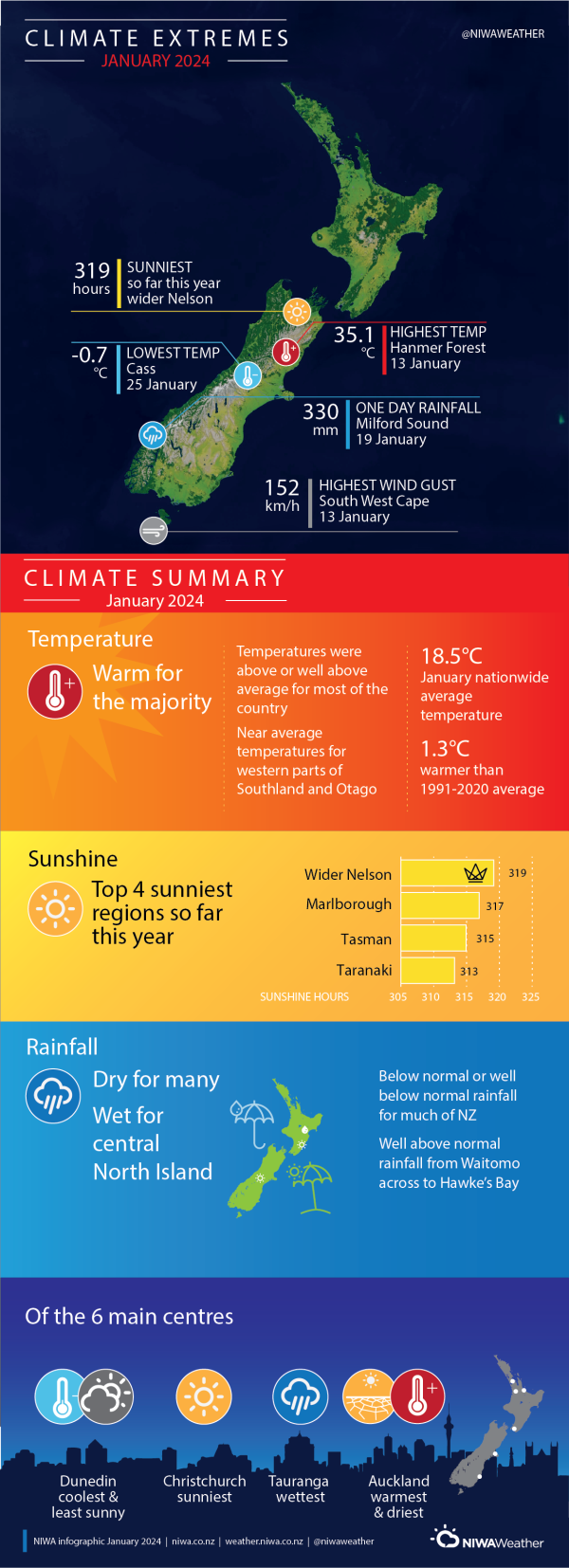| Temperature | Temperatures were above average (0.51-1.20°C above average) or well above average (>1.20°C above average) across most of the country. Temperatures were near average (±0.50°C of average) in western parts of Southland and Otago, and parts of Central Otago. |
| Rainfall | Below normal (50-79% of normal) or well below normal (<50% of normal) rainfall was observed across northern, western, and southern parts of the North Island, and northern, eastern, and inland parts of the South Island. Above normal (120-149% of normal) or well above normal (>149% of normal) rainfall was observed across central and eastern parts of the North Island, and western parts of the South Island. |
| Soil Moisture | At the end of January, soil moisture levels were lower than normal in parts of Northland, southern Taranaki, Wairarapa, Wellington, Nelson, Marlborough, and north Canterbury. Areas of meteorological drought were present in parts of Marlborough and far northern Canterbury according to the New Zealand Drought Index. Soil moisture levels were higher than normal across central parts of the North Island from Waitomo to Hawke’s Bay, and northwestern parts of the South Island. |
Overview
January 2024 was characterised by higher than normal mean sea level pressure (MSLP) to the east of Aotearoa New Zealand, with more northerly airflows than normal. Meanwhile, a marine heatwave intensified in New Zealand coastal waters during the month. This contributed to temperatures that were above average (0.51-1.20°C above average) or well above average (>1.20°C above average) across nearly all of the country in January. The exception was western parts of Southland and Otago, and parts of Central Otago, where temperatures were near average (±0.50°C of average) for the month. The nationwide average temperature in January 2024 was 18.5°C. This was 1.3°C above the 1991-2020 January average from NIWA’s seven station temperature series which begins in 1909, and New Zealand’s 8th-warmest January on record.
It was a dry month for many parts of the country, with below normal (50-79% of normal) or well below normal (<50% of normal) rainfall in Northland, Auckland, northern Waikato, eastern Bay of Plenty, much of the western and southern North Island from Taranaki to Wellington, Tasman, Nelson, Marlborough, Canterbury, and Otago. Rainfall totals for the month were above normal (120-149% of normal) or well above normal (>149% of normal) for parts of Gisborne, Hawke’s Bay, the Central Plateau, Waitomo, central and southern parts of the West Coast, parts of western Southland, and northwestern Otago.
Sunshine was abundant for northern and eastern parts of the South Island. Christchurch recorded 297 hours of sunshine, making it the city’s sunniest January since records began in 1930. Farther north, Blenheim observed 317 hours of sunshine, which was the town’s fourth-highest January sunshine total since records began in 1930.
Further Highlights:
- The highest temperature was 35.1°C, observed at Hanmer Forest on 13 January.
- The lowest temperature was -0.7°C, observed at Cass (inland Canterbury) on 25 January.
- The highest 1-day rainfall was 330 mm, recorded at Milford Sound on 19 January.
- The highest wind gust was 152 km/h, observed at South West Cape on 13 January.
- Of the six main centres in January 2024, Auckland was the warmest and driest, Christchurch was the sunniest, Dunedin was the coolest and least sunny, and Tauranga was the wettest.
- Of the available, regularly reporting sunshine observation sites, the sunniest four locations so far in 2024 are wider Nelson (319 hours), Marlborough (317 hours), Tasman (315 hours) and Taranaki (313 hours).


